Review: Nokia Navigation Kit for N800 Internet Tablet
Jul 12, 2007 — by LinuxDevices Staff — from the LinuxDevices Archive — 7 views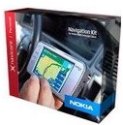 Nokia's Navigation Kit for the N800 Internet Tablet works great when used in a car in metropolitan outskirts. However, the unit seems a bit pricey for what you get, is ill-suited to outdoor use, and seems to struggle holding a fix when the battery gets low.
Nokia's Navigation Kit for the N800 Internet Tablet works great when used in a car in metropolitan outskirts. However, the unit seems a bit pricey for what you get, is ill-suited to outdoor use, and seems to struggle holding a fix when the battery gets low.
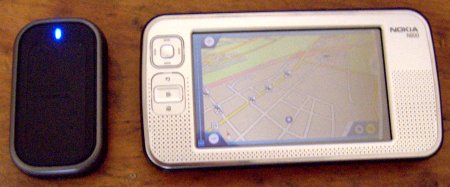
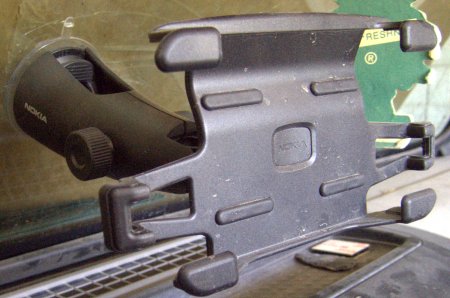
The LD-3W GPS unit, Nokia N800, and holder unit
digg this story |
The Kit consists of a small, Nokia-branded “LD-3W” hardware GPS receiver unit, a sturdy, highly configurable windshield mount for the N800, and a 2GB SD card containing navigation software and maps (choose Europe or North America/Canada). TeleAtlas supplied the maps, while the navigation software was supplied by Navicore, a small, recently-acquired (by Wayfinder) company based in Espoo, Finland.
| Navicore screenshots (Click any to enlarge) 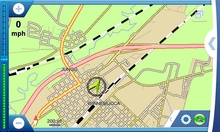 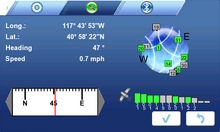 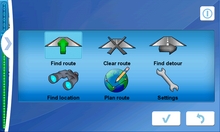 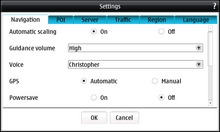 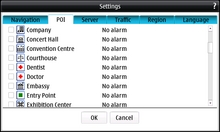 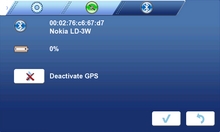 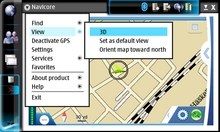 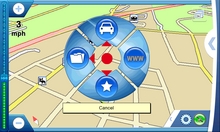 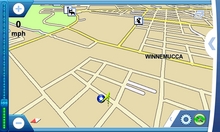 Navicore Screenshots (Click any to enlarge) |
We tried out the GPS device initially in a small, rural town in Northern Nevada. In an open Jeep, it gained a location fix quickly, and kept us entertained with odd, synthesized Britishisms mixed into the directions. “There, that wasn't really so bad now, was it?” its default “Christopher” voice might announce, as we neared our destination.
However, the N800's screen fared poorly in direct sunshine, even turned up all the way, a setting bound to drain the battery very quickly. And, we worried about how long the receiver and N800 might survive in the Jeep, let alone on a bicycle or backpack. Neither unit is sealed in any way against dust and water infiltration, making them pretty impractical in any kind of camping situation — arguably something a couple of plastic bags might fix. Additionally, the N800's battery life will be much, much shorter than that of a typical handheld GPS, which can go all day.
We like how nicely the little GPS hardware unit matched the N800 in size and shape, though, making it easy to hold the two at the same time. We also liked that Nokia included an adhesive and velcro kit to mount the LD-3W receiver in an optimal location, such as behind the rear-view mirror in a convertible, or to the dashboard at the far center of the windshield.
As we expected, given our small-town location, the TeleAtlas map data was pretty outdated, strewn with OCR (optical character recognition) errors (Baum Road instead of Baud Street?), and worthless once we reached the edge of town, where whole subdivisions went missing. That probably wouldn't be the case for more populous areas, though.
Next, we tested the device on a train trip to San Francisco. Even in the skylight-lined observation car, the receiver failed to get a fix on its location. When this pattern repeated itself while walking around San Francisco's urban canyons, we actually thought we might have received a defective unit. Our ultra-basic $100 monochrome Garmin Etrex worked fine in both situations.
However, every once in a while, just to surprise us, the device would actually work. When it did, we certainly were impressed by the huge “POI” (points of interest) database. In an urban location such as San Francisco, the screen becomes crowded with POIs. The interface for filtering some out requires using the stylus.
Topping up the charge might have helped, but the device came only with a car charger. And, despite having the same physical connector as the N800, the voltage and current ratings for the two devices are different, making us reluctant to try using their chargers interchangeably.
Eventually, we did try charging the LD-3W with the N800's charger. It actually seemed to work, although the Navicore software started showing “[not available]” on the screen meant to display the GPS unit's battery charge level.
Some miscellaneous positive points:
- Ability to position the LD-3W receiver and N800 display unit independently when used in a car
- The N800's hi-res display seems made for maps
- The GPS receiver reportedly works with alternative GPS applications, such as Maemo Maps (but so may less expensive Bluetooth-enabled GPS receivers)
- Voice synthesizer is easy to understand, and is entertaining
- The included N800 windshield mount is tremendous, and works with the 770 too (with the hard cover removed)
- User-replaceable battery
- Mapdata divided into US-East, US-West, and Canada-Alaska, so unneeded data can be easily backed up and deleted, to free up room for MP3s
- European users can add traffic data and “safety camera” subscriptions
- Installer on CD includes a version for the 770
Negative observations:
- May not be price/feature/performance-competitive with standalone handheld GPS units
- No obvious way to save breadcrumbs for use with external GIS or cartography programs, such as grass or Google Earth
- No obvious way to use your own map data
- No obvious way to change the map projection or datum, so that you could use the GPS with, for instance, UTM-based U.S. government maps
- Mapdata included on CD, but packed in “.cab” files
- Windows-only installer needed to restore map data or add foreign-language voices to the card (though the installer seemed to work okay under WINE)
In summary, the Navigation Kit for Nokia N800 Internet Tablet will likely please casual suburban GPS users wishing to use the device almost exclusively for automotive navigation. Clearly, this is the target market.
The Kit is lots of fun to play with, but ultimately has a toy-like feel compared to real GPS equipment. You wouldn't really want to use it to make maps, or find your way around the woods.
Considering how mainstream GPS and Bluetooth have become, the cost certainly isn't in the hardware. Given the existence of open source navigation software alternatives for the N800 such as Maemo Mapper, it seems as if you're really paying mostly for the map data and POI database. And indeed, that alone may more than justify the cost for some users (night-time delivery drivers spring to mind).
Most anyone else would probably get more enjoyment from a year's subscription to the interesting Rhapsody service for the N800, though.
Availability
The Navigation Kit for Nokia N800 Internet Tablet is widely available, priced at about $250.
Henry Kingman is Senior Editor of LinuxDevices.com
This article was originally published on LinuxDevices.com and has been donated to the open source community by QuinStreet Inc. Please visit LinuxToday.com for up-to-date news and articles about Linux and open source.